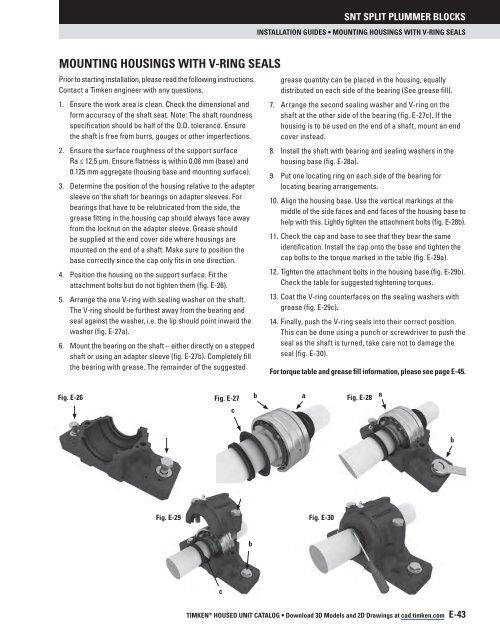You also want an ePaper? Increase the reach of your titles
YUMPU automatically turns print PDFs into web optimized ePapers that Google loves.
<strong>SNT</strong> SPLIT PLUMMER BLOCKS<br />
INSTALLATION GUIDES • MOUNTING HOUSINGS WITH V-RING SEALS<br />
MOUNTING HOUSINGS WITH V-RING SEALS<br />
Prior to starting installation, please read the following instructions.<br />
Contact a <strong>Timken</strong> engineer with any questions.<br />
1. Ensure the work area is clean. Check the dimensional and<br />
form accuracy of the shaft seat. Note: The shaft roundness<br />
specification should be half of the O.D. tolerance. Ensure<br />
the shaft is free from burrs, gouges or other imperfections.<br />
2. Ensure the surface roughness of the support surface<br />
Ra ≤ 12.5 μm. Ensure flatness is within 0.08 mm (base) and<br />
0.125 mm aggregate (housing base and mounting surface).<br />
3. Determine the position of the housing relative to the adapter<br />
sleeve on the shaft for bearings on adapter sleeves. For<br />
bearings that have to be relubricated from the side, the<br />
grease fitting in the housing cap should always face away<br />
from the locknut on the adapter sleeve. Grease should<br />
be supplied at the end cover side where housings are<br />
mounted on the end of a shaft. Make sure to position the<br />
base correctly since the cap only fits in one direction.<br />
4. Position the housing on the support surface. Fit the<br />
attachment bolts but do not tighten them (fig. E-26).<br />
5. Arrange the one V-ring with sealing washer on the shaft.<br />
The V-ring should be furthest away from the bearing and<br />
seal against the washer, i.e. the lip should point inward the<br />
washer (fig. E-27a).<br />
6. Mount the bearing on the shaft – either directly on a stepped<br />
shaft or using an adapter sleeve (fig. E-27b). Completely fill<br />
the bearing with grease. The remainder of the suggested<br />
grease quantity can be placed in the housing, equally<br />
distributed on each side of the bearing (See grease fill).<br />
7. Arrange the second sealing washer and V-ring on the<br />
shaft at the other side of the bearing (fig. E-27c). If the<br />
housing is to be used on the end of a shaft, mount an end<br />
cover instead.<br />
8. Install the shaft with bearing and sealing washers in the<br />
housing base (fig. E-28a).<br />
9. Put one locating ring on each side of the bearing for<br />
locating bearing arrangements.<br />
10. Align the housing base. Use the vertical markings at the<br />
middle of the side faces and end faces of the housing base to<br />
help with this. Lightly tighten the attachment bolts (fig. E-28b).<br />
11. Check the cap and base to see that they bear the same<br />
identification. Install the cap onto the base and tighten the<br />
cap bolts to the torque marked in the table (fig. E-29a).<br />
12. Tighten the attachment bolts in the housing base (fig. E-29b).<br />
Check the table for suggested tightening torques.<br />
13. Coat the V-ring counterfaces on the sealing washers with<br />
grease (fig. E-29c).<br />
14. Finally, push the V-ring seals into their correct position.<br />
This can be done using a punch or screwdriver to push the<br />
seal as the shaft is turned, take care not to damage the<br />
seal (fig. E-30).<br />
For torque table and grease fill information, please see page E-45.<br />
Fig. E-26<br />
Fig. E-27<br />
c<br />
b<br />
a<br />
Fig. E-28<br />
a<br />
b<br />
a<br />
Fig. E-29<br />
Fig. E-30<br />
b<br />
c<br />
TIMKEN ® HOUSED UNIT CataloG • Download 3D Models and 2D Drawings at cad.timken.com E-43

















